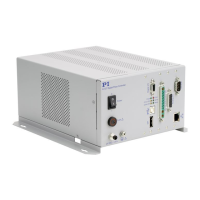User Manual
E727T0005, valid for E-727
BRO, 2019-06-28
Physik Instrumente (PI) GmbH & Co. KG, Auf der Roemerstrasse 1, 76228 Karlsruhe, Germany Page 136 / 240
Phone +49 721 4846-0, Fax +49 721 4846-1019, Email info@pi.ws, www.pi.ws
Adjusting the Notch Filter(s) in Open-Loop Operation
The corrections by a notch filter only take place in closed-loop operation by default, but can also
be enabled for open-loop operation. The appropriate frequency component is reduced in the
control value to compensate for undesired resonances in the mechanical system. Adjusting the
notch filter frequency can be useful, particularly in the case of very high loads.
For further details, see “Notch Filters”, p. 37.
INFORMATION
The notch rejection value, which scales the damping done by the notch filter, should always be
0.05. A notch rejection value of 1 deactivates the notch filter.
Before you measure the resonant frequencies as described below, make sure that the notch filters
are not enabled in open-loop operation. To do this, check the value of the Enable Notch In Open
Loop parameter, ID 0x08000500, for the axis (0 = disable notch filter in open-loop operation; 1 =
enable notch filter in open-loop operation). You can do this in the Servo parameter group of the
Device Parameter Configuration window in PIMikroMove.
In addition to the measurement described below, you can create a Bode plot: In the PIMikroMove
main window, open the Data Recorder window via the E-727… > Show data recorder … menu
item. At the bottom of the Data Recorder window, enter the Amplitude value and click Estimate
to start the frequency response.
INFORMATION — SCREENSHOTS
The screenshots in the following instructions were created with an E-712 digital multi-axis
controller. With E-727, some values may differ, but the procedure outlined in the screenshots is as
with E-712.
To measure the resonant frequency and adjust the notch filter(s), a frequency response (axis
response to an impulse) is recorded in open-loop operation.
Proceed as follows for each axis:
1. Read the “General Notes on Servo-Controller Dynamic Tuning” (p. 134).
2. Make sure the stage is mounted in exactly the same way as in the application. The load
on the stage is especially important.
3. In the main window of PIMikroMove, open the Piezo Dynamic Tuner window via the E-
727… > Dynamic Tuner … menu item.
4. Configure the frequency response in the Piezo Dynamic Tuner window:
a) Make sure that the correct axis is selected (Axis drop down list).
b) Enter suitable values for the start value (Offset:) and the amplitude (Amplitude:) of
the impulse in the Step panel. The start value should be 0, and the amplitude
should be about 10 % of the axis travel range.
c) Make sure that the axis is in open-loop operation (Servo / Closed Loop box is not
checked).

